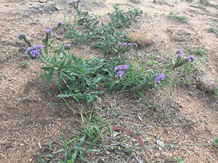Watch out for summer weeds
04 Dec 2018
Dr Belinda Edmonstone, Forbes District Veterinarian
With sporadic storms in the central west and plenty of bare paddocks many summer weeds are beginning to germinate. Some of these can be toxic to livestock.
- Catheads or caltrop (Tribulus terrestris) and some of the panic grasses (Panicum spp.) can be toxic to livestock. These plants are capable of causing sporadic episodes of severe acute liver disease with secondary photosensitisation. The primary toxin is a saponin which results in crystals forming in the liver causing liver disease. A second unknown factor is also thought to contribute and hence the sporadic nature of the disease. The risk period appears to be for about 10 days after short rainfall events that occur during an otherwise dry summer. Clinically the affected sheep are depressed with swollen floppy ears, swollen eyes and swelling under the jaw. In the early stages you may just see them flicking their head continuously as though flies are bothering them. As the disease progresses they become more depressed, go down and die. Juvenile sheep and goats seem to be the most susceptible. As a control observe stock closely for up to 10 days after rain and remove them if there is a problem. Affected stock can be put in the shed during the day (to treat the photosensitisation) and may survive if the liver damage is not to major. Some have success with anti-inflammatories. Alternatively graze adult stock and cattle on risky pastures.
 Common and blue heliotrope (Heliotropium spp.) (pictured right) contains pyrrolizidine alkaloids (the same toxin found in Paterson’s Curse). It causes chronic liver damage. The amount of liver damaged caused is dependent on the amount of the toxin ingested and the species eating it. Cattle and horses are much more susceptible to the toxin than sheep. However sheep (particularly crossbreds and British breeds) are more likely to eat it and are therefore the animals most commonly affected. Clinical signs are generally seen some time after grazing the weed. In sheep the most common syndrome is copper toxicity secondary to the liver damage. A stressful triggers results in release of copper from the damaged liver causing breakdown of red blood cells. Sheep are generally observed off by themselves one day and then dead the next. The colour of their skin is bright yellow. Treatment involves giving them a molybdate drench to bind the copper however this is only a short term solution as their liver is permanently damaged. Prevention by minimising intake of Heliotrope is the best solution.
Common and blue heliotrope (Heliotropium spp.) (pictured right) contains pyrrolizidine alkaloids (the same toxin found in Paterson’s Curse). It causes chronic liver damage. The amount of liver damaged caused is dependent on the amount of the toxin ingested and the species eating it. Cattle and horses are much more susceptible to the toxin than sheep. However sheep (particularly crossbreds and British breeds) are more likely to eat it and are therefore the animals most commonly affected. Clinical signs are generally seen some time after grazing the weed. In sheep the most common syndrome is copper toxicity secondary to the liver damage. A stressful triggers results in release of copper from the damaged liver causing breakdown of red blood cells. Sheep are generally observed off by themselves one day and then dead the next. The colour of their skin is bright yellow. Treatment involves giving them a molybdate drench to bind the copper however this is only a short term solution as their liver is permanently damaged. Prevention by minimising intake of Heliotrope is the best solution.- Quena (Solanum esuriale) has been linked to a condition known as ‘humpy back’ in full woolled merino sheep exposed to it over the summer months. When mustered these sheep lag behind, develop a ‘humpy back’ posture and are unable to travel. Some will recover and some won’t.
Producers should also consider that ‘new’ weeds not typical to the district may have been introduced to their property if they have purchased in feed sources from further afield. It is important to get these identified to establish if they are toxic and how to control them.
For more information on weed toxicity, contact your Local Land Services District Vet or alternatively for general information on weeds, including identification and control methods, visit NSW DPI WeedWise